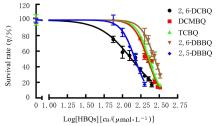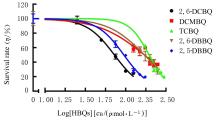Journal of Jilin University(Medicine Edition) ›› 2023, Vol. 49 ›› Issue (3): 640-646.doi: 10.13481/j.1671-587X.20230312
• Research in basic medicine • Previous Articles Next Articles
Analysis on structure and toxicity of water disinfection by-products halobenzoquinones
Haiying DU1( ),Yongli JIANG2,Yingguan WEI1,3,Jinhua LI1,Rifeng LU1
),Yongli JIANG2,Yingguan WEI1,3,Jinhua LI1,Rifeng LU1
- 1.Department of Health Toxicology,School of Public Health,Jilin University,Changchun 130021,China
2.Changchun Customs Port Outpatient Department,Jilin International Travel Health Care Center,Changchun 130062,China
3.Hechi Center for Disease Control and Prevention,Guangxi Zhuang Autonomous Region,Hechi 547000,China
-
Received:2022-06-27Online:2023-05-28Published:2023-06-20 -
Contact:Haiying DU E-mail:hydu@jlu.edu.cn
CLC Number:
- R114
Cite this article
Haiying DU,Yongli JIANG,Yingguan WEI,Jinhua LI,Rifeng LU. Analysis on structure and toxicity of water disinfection by-products halobenzoquinones[J].Journal of Jilin University(Medicine Edition), 2023, 49(3): 640-646.
share this article
Tab. 3
Structural parameters of HBQs"
| HBQs | Molecular formula | logP | pKa | R | S | V | μ | EHOMO | ELUMO |
|---|---|---|---|---|---|---|---|---|---|
| 2,6-DCBQ | C6H2Cl2O2 | 0.65 | 6.30 | 37.0 | 151.60 | 113.1 | 0.881 | -10.977 | -2.476 |
| 2,6-DBBQ | C6H2Br2O2 | 0.98 | 6.00 | 42.7 | 159.29 | 110.7 | 0.848 | -10.464 | -2.421 |
| 2,5-DBBQ | C6H2Br2O2 | 0.98 | 5.90 | 42.7 | 59.34 | 110.7 | 0.270 | -10.462 | -2.424 |
| DCMBQ | C7H4Cl2O2 | 1.77 | 5.80 | 44.0 | 90.95 | 136.1 | 1.449 | -9.989 | -2.631 |
| TCBQ | C6HCl3O2 | 1.02 | 5.70 | 41.6 | 166.30 | 124.6 | 0.971 | -10.598 | -2.634 |
Tab. 4
Correlations between lgIC50 of HBQs and structural parameters of HBQs detected by MTS and NRU methods"
| Parameter | MTS method | NRU method | ||
|---|---|---|---|---|
| P value | R2 | P value | R2 | |
| logP | 0.441 | 0.208 | 0.303 | 0.339 |
| pKa | 0.311 | 0.330 | 0.109 | 0.629 |
| R | 0.245 | 0.410 | 0.188 | 0.490 |
| V | 0.575 | 0.116 | 0.333 | 0.306 |
| S | 0.465 | 0.189 | 0.292 | 0.351 |
| μ | 0.435 | 0.212 | 0.377 | 0.263 |
| EHOMO | 0.357 | 0.282 | 0.274 | 0.373 |
| ELUMO | 0.612 | 0.096 | 0.321 | 0.319 |
Tab. 5
Correlations between lgIC50 of HBQs and structural parameters of HBQs after removal of DCMBQ detected by MTS and NRU method"
| Parameter | MTS method | NRU method | ||
|---|---|---|---|---|
| P value | R2 | P value | R2 | |
| logP | 0.441 | 0.208 | 0.303 | 0.339 |
| pKa | 0.311 | 0.330 | 0.109 | 0.629 |
| R | 0.245 | 0.410 | 0.188 | 0.490 |
| V | 0.575 | 0.116 | 0.333 | 0.306 |
| S | 0.465 | 0.189 | 0.292 | 0.351 |
| μ | 0.435 | 0.212 | 0.377 | 0.263 |
| EHOMO | 0.357 | 0.282 | 0.274 | 0.373 |
| ELUMO | 0.612 | 0.096 | 0.321 | 0.319 |
| 1 | HUANG R F, WANG W, QIAN Y C, et al. Ultra pressure liquid chromatography-negative electrospray ionization mass spectrometry determination of twelve halobenzoquinones at ng/L levels in drinking water[J]. Anal Chem, 2013, 85(9): 4520-4529. |
| 2 | WANG W, QIAN Y C, BOYD J M, et al. Halobenzoquinones in swimming pool waters and their formation from personal care products[J]. Environ Sci Technol, 2013, 47(7): 3275-3282. |
| 3 | QIN F, ZHAO Y Y, ZHAO Y L, et al. A toxic disinfection by-product, 2, 6-dichloro-1, 4-benzoquinone, identified in drinking water[J]. Angew Chem Int Ed Engl, 2010, 49(4): 790-792. |
| 4 | LI J H, WANG W, MOE B, et al. Chemical and toxicological characterization of halobenzoquinones, an emerging class of disinfection byproducts[J]. Chem Res Toxicol, 2015, 28(3): 306-318. |
| 5 | BULL R J, RECKHOW D A, LI X F, et al. Potential carcinogenic hazards of non-regulated disinfection by-products: haloquinones, halo-cyclopentene and cyclohexene derivatives, N-halamines, halonitriles, and heterocyclic amines[J]. Toxicology,2011, 286(1/2/3): 1-19. |
| 6 | LI J H, MOE B, VEMULA S, et al. Emerging disinfection byproducts, halobenzoquinones: effects of isomeric structure and halogen substitution on cytotoxicity, formation of reactive oxygen species, and genotoxicity[J]. Environ Sci Technol, 2016, 50(13): 6744-6752. |
| 7 | ZUO Y T, HU Y, LU W W, et al. Toxicity of 2, 6-dichloro-1, 4-benzoquinone and five regulated drinking water disinfection by-products for the Caenorhabditis elegans nematode[J]. J Hazard Mater, 2017, 321: 456-463. |
| 8 | LECURIEUX F, MARZIN D, ERB F. Study of the genotoxic activity of five chlorinated propanones using the SOS chromotest, the Ames-fluctuation test and the newt micronucleus test[J]. Mutat Res, 1994, 341(1): 1-15. |
| 9 | PROCHÁZKA E, ESCHER B I, PLEWA M J, et al. In vitro cytotoxicity and adaptive stress responses to selected haloacetic acid and halobenzoquinone water disinfection byproducts[J]. Chem Res Toxicol, 2015, 28(10): 2059-2068. |
| 10 | PLEWA M J, WAGNER E D, RICHARDSON S D, et al. Chemical and biological characterization of newly discovered iodoacid drinking water disinfection byproducts[J]. Environ Sci Technol, 2004, 38(18): 4713-4722. |
| 11 | ATTENE-RAMOS M S, WAGNER E D, PLEWA M J.Comparative human cell toxicogenomic analysis of monohaloacetic acid drinking water disinfection byproducts[J]. Environ Sci Technol, 2010, 44(19): 7206-7212. |
| 12 | KARELSON M, LOBANOV V S, KATRITZKY A R. Quantum-chemical descriptors in QSAR/QSPR studies[J]. Chem Rev, 1996, 96(3): 1027-1044. |
| 13 | MÉNDEZ-HERNÁNDEZ D D, TARAKESHWAR P, GUST D, et al. Simple and accurate correlation of experimental redox potentials and DFT-calculated HOMO/LUMO energies of polycyclic aromatic hydrocarbons[J]. J Mol Model, 2013,19(7):2845-2848. |
| 14 | YEOM Y, HAN J, ZHANG X,et al.A review on the degradation efficiency,DBP formation,and toxicity variation in the UV/chlorine treatment of micropollutants[J]. Chem Eng J, 2021, 424: 130053. |
| 15 | LIU J Q, ZHANG X R. Comparative toxicity of new halophenolic DBPs in chlorinated saline wastewater effluents against a marine alga: halophenolic DBPs are generally more toxic than haloaliphatic ones[J]. Water Res, 2014, 65: 64-72. |
| 16 | ALAMIERY A. Corrosion inhibition effect of 2-N-phenylamino-5-(3-phenyl-3-oxo-1-propyl)-1, 3, 4-oxadiazole on mild steel in 1 M hydrochloric acid medium: insight from gravimetric and DFT investigations[J]. Mater Sci Energy Technol, 2021, 4: 398-406. |
| 17 | HUNG S, MOHAN A, RECKHOW D A, et al. Assessment of the in vitro toxicity of the disinfection byproduct 2, 6-dichloro-1, 4-benzoquinone and its transformed derivatives[J]. Chemosphere, 2019, 234: 902-908. |
| 18 | YANG M T, ZHANG X R. Comparative developmental toxicity of new aromatic halogenated DBPs in a chlorinated saline sewage effluent to the marine polychaete Platynereis dumerilii[J]. Environ Sci Technol, 2013, 47(19): 10868-10876. |
| 19 | RYBICKA-JASIŃSKA K, VUIIEV V I. Molecular electrets-Why do dipoles matter for charge transfer and excited-state dynamics? [J]. J Photochem Photobiol A Chem, 2020, 401: 112779. |
| 20 | CHAN K T, JENSEN N, O’BRIEN P J. Structure-activity relationships for thiol reactivity and rat or human hepatocyte toxicity induced by substituted p-benzoquinone compounds[J]. J Appl Toxicol, 2008, 28(5): 608-620. |
| 21 | SIRAKI A G, CHAN T S, O'BRIEN P J. Application of quantitative structure-toxicity relationships for the comparison of the cytotoxicity of 14 p-benzoquinone congeners in primary cultured rat hepatocytes versus PC12 cells[J]. Toxicol Sci, 2004, 81(1): 148-159. |
| 22 | LIU Z Y, DANG K, GAO J H, et al. Toxicity prediction of 1, 2, 4-triazoles compounds by QSTR and inter species QSTTR models[J]. Ecotoxicol Environ Saf, 2022, 242: 113839. |
| [1] | Lili HUANG,Yuxuan LIU,Kaiyi FANG,Yeteng MU,Nannan HU,Chong GUO,Fuxu YANF,Xingang GUAN. Preparation of oxaliplatin-loaded cell membrane nanodrugs and its killing effect on colon cancer cells of mice [J]. Journal of Jilin University(Medicine Edition), 2021, 47(6): 1422-1428. |
| [2] | Han WANG,Zilu TIAN,Xuanyan ZHU,Yubin YANG,Song ZHU. Preparation of cinnamaldehyde antibacterial adhesive and evaluation on its antibacterial property [J]. Journal of Jilin University(Medicine Edition), 2021, 47(5): 1116-1123. |
| [3] | Qing SHA,He LI,Hong ZHANG,Boqun CHENG,Ying WANG,Linlin YAN,Xinying ZOU,Zhimin ZHANG. Effects of EDC on immediate and aging micro-tensile bonding strength of dentin [J]. Journal of Jilin University(Medicine Edition), 2021, 47(1): 173-179. |
| [4] | PAN Tao, GUO Caixia, JIN Minghua, LIU Xiaomei, LIU Ying, DU Haiying, SUN Zhiwei. Cytotoxicity of SiO2 nanoparticles on liver HL-7702 cells [J]. Journal of Jilin University Medicine Edition, 2015, 41(05): 885-890. |
| [5] | XIA Yinye, LI Yanbo, NIU Piye, WANG Hui, WANG Yifei, LIANG Baolu, ZHAO Feng, GUO Caixia, SUN Zhiwei. Toxicity of silica nanoparticles on vascular endothelial cells and its induction effect on apoptosis [J]. Journal of Jilin University Medicine Edition, 2015, 41(03): 454-459. |
| [6] | GENG Weijia, LI Yang, YU Yongbo, YU Yang, DUAN Junchao, YANG Yumei, ZOU Yang, SUN Zhiwei. Inhibitory effects of N-acetyl-cysteine on SiO2 nanoparticles-induced cytotoxicity [J]. Journal of Jilin University Medicine Edition, 2015, 41(03): 486-490. |
| [7] | LI Yan-bo,ZHOU Wei,YU Yong-bo,DUAN Jun-chao,GUO Cai-xia,SUN Zhi-wei. Cytotoxicity and oxidative damage effect of silica nanoparticles on vascular endothelial cells [J]. Journal of Jilin University Medicine Edition, 2014, 40(03): 476-481. |
| [8] | ZHANG Xiao-yan,LI Zheng-qiang,SUN Ying,WANG Guan-xun,ZHENG Lu,HAN Bing. Biocompatibility of a non-woven silk fibroin and poly L-lactic acid net and evaluation on its safety [J]. Journal of Jilin University Medicine Edition, 2014, 40(03): 578-582. |
| [9] | DU Ou,GAI Li-ting,WANG Min-yan,JIANG Qiu. Mechanical properties and cytotoxicity of polylactic acid/hydroxyapatite composites [J]. Journal of Jilin University Medicine Edition, 2014, 40(02): 300-305. |
| [10] | PAN Tao,JIN Ming-hua,LIU Xiao-mei,DU Zhong-jun,ZHOU Xian-qing,HUANG Pei-li,SUN Zhi-wei. Cytotoxicity and effect on GJIC of SiO2 nanoparticles in HL-7702 cells [J]. Journal of Jilin University Medicine Edition, 2013, 39(2): 222-226. |
| [11] | DU Hai-ying,WANG Hua,JIN Ming-hua,XU Yan-ling,LI Peng,SUN Zhi-wei. Mechanism of DNA damage induced by cadmium chloride in rat H9c2 cells [J]. J4, 2011, 37(6): 1043-1046. |
| [12] | JIANG Ya-ping,SONG Wen-zhi,YIN Wan-zhong,YANG Huan,ZHANGTian-fu,WANG Wei. Cytotoxicity of gold nano-flower particles to human fibroblasts in vitro [J]. J4, 2011, 37(4): 651-654. |
| [13] | . Distribution |of silica nanoparticles in HepG2cells and its relationship with |cytotoxicity [J]. J4, 2011, 37(2): 236-240. |
| [14] | ZHANG Ying-yu, ZHANG Xin-mu,WANG Jian-qiu,ZHANG Lei,JIAO Ping,WANG Ding-ding,WANG Wen-jia,MA-Jie,YAN Wei-qun. Establisment of anti-CD3 monoclonal antibody activated killer cells proliferation system and cytotoxic activity [J]. J4, 2007, 33(2): 265-268. |
| [15] | HAN Wei, GONG Ping, CHANG Ming , ZHANG Yu, ZHANG Ying, WANG Qiu-yan, HU Yi-hong , HU Lin-sen. Mechanism of cytotoxicity induced by rotenone in PC12 cells [J]. J4, 2007, 33(1): 98-101. |
|







